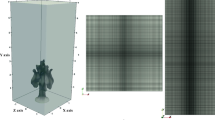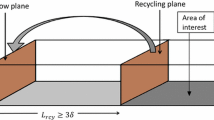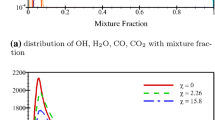Abstract
Using discretization technique is one of the challenges associated with numerical modeling. In the Large Eddy Simulation (LES) method, this issue becomes more critical because it affects the sub-grid scale (SGS) model and creates errors. Using an LES method, we investigated the numerical errors and compatibility of different discretization methods with SGS in pool fire modeling. First-order, central, and second-order upwind and linear upwind stabilized transport (LUST) schemes were examined in Smagorinsky (S_SGS) and k-equation (K_SGS) sub-grid scales. First-order upwind and second-order upwind methods estimated the velocity field, temperature, and perturbation with a significant error, so that in the plume area, there was 90% error with the first-order upwind and 50% error with the second-order upwind concerning the results of the mean square horizontal velocity perturbation. With an error of 20%, the LUST method had a better agreement with the experimental results. Besides, SGS did not have a significant effect on the results of this method. However, the second-order upwind method was more consistent with the S_SGS model. To improve the results of upwind methods, Quadratic Upstream Interpolation for Convective Kinematics and Monotonic Upwind Scheme for Conservation Laws discretization methods are recommended.














Similar content being viewed by others
References
Razeghi SMJ, Safarzadeh M, Pasdarshahri H (2020) Comparison of combustion models based on fast chemistry assumption in large eddy simulation of pool fire. J Braz Soc Mech Sci Eng 42:208. https://doi.org/10.1007/s40430-020-02291-9
Pasdarshahri H, Heidarinejad G, Mazaheri K (2012) Large eddy simulation on one-meter methane pool fire using one-equation sub-grid scale model. MCS, pp 11–15
Breuer M (1998) Numerical and modeling influences on large eddy simulations for the flow past a circular cylinder. Int J Heat Fluid Flow 19:512–521
Zhiyin Y (2015) Large-eddy simulation: past, present and the future. Chin J Aeronaut 28:11–24
Rodi W, Ferziger J, Breuer M, Pourquiée M (1997) Status of large eddy simulation: results of a workshop. J Fluids Eng 119:248–262
Mittal R, Moin P (1997) Suitability of upwind-biased finite difference schemes for large-eddy simulation of turbulent flows. AIAA J 35:1415–1417
Lee SB (2017) A study on temporal accuracy of OpenFOAM. Int J Naval Architect Ocean Eng 9:429–438
Chen H, Li Z, Yufei Z (2017) U or v shape: dissipation effects on cylinder flow implicit large-eddy simulation. AIAA J 55:459–473
El Rafei M, Könözsy L, Rana Z (2017) Investigation of numerical dissipation in classical and implicit large eddy simulations. Aerospace 4(4):59
Trisjono P, Kang S, Pitsch H (2016) On a consistent high-order finite difference scheme with kinetic energy conservation for simulating turbulent reacting flows. J Comput Phys 327:612–628
Sedano CA, López OD, Ladino A, Muñoz F (2017) Prediction of a small-scale pool fire with fireFoam. Int J Chem Eng 2017:4934956
Sikanen T, Hostikka S (2017) Predicting the heat release rates of liquid pool fires in mechanically ventilated compartments. Fire Saf J 91:266–275
Yuen AC, Yeoh GH, Timchenko V, Cheung SC, Chan QN, Chen T (2017) On the influences of key modelling constants of large eddy simulations for large-scale compartment fires predictions. Int J Comput Fluid Dyn 31:324–337
Yuen A, Yeoh G, Timchenko V, Barber T (2015) LES and multi-step chemical reaction in compartment fires. Numer Heat Transf Part A Appl 68:711–736
Maragkos G, Merci B (2017) Large Eddy simulations of CH4 fire plumes. Flow Turbul Combust 99:239–278
Wimer NT, Day MS, Lapointe C, Makowiecki AS, Glusman JF, Daily JW et al. (2019) High-resolution numerical simulations of a large-scale helium plume using adaptive mesh refinement. arXiv:1901.10554
Segovia JFP, Beji T, Merci B (2018) Assessment of an evaporation model in CFD simulations of a free liquid pool fire using the mass transfer number approach. Flow Turbul Combust, pp 1–14
Tieszen S, O’hern T, Schefer R, Weckman E, Blanchat T (2002) Experimental study of the flow field in and around a one meter diameter methane fire. Combust Flame 129:378–391
Mitsopoulos EP, Lytras I, Koutmos P (2019) Large eddy simulations of premixed CH4 bluff-body flames operating close to the lean limit using quasi-global chemistry and an algebraic chemiluminescence model. Theor Comput Fluid Dyn 33:325–340. https://doi.org/10.1007/s00162-019-00497-9
Cheung SC, Yeoh G (2009) A fully-coupled simulation of vortical structures in a large-scale buoyant pool fire. Int J Therm Sci 48:2187–2202
Ries F, Nishad K, Dressler L, Janicka J, Sadiki A (2018) Evaluating large eddy simulation results based on error analysis. Theoret Comput Fluid Dyn 32:733–752
Maragkos G, Beji T, Merci B (2019) Towards predictive simulations of gaseous pool fires. Proc Combust Inst 37:3927–3934
Yeoh G-H, Yuen KK (2009) Computational fluid dynamics in fire engineering: theory, modelling and practice. Butterworth-Heinemann, Oxford
Maragkos G, Beji T, Merci B (2017) Advances in modelling in CFD simulations of turbulent gaseous pool fires. Combust Flame 181:22–38
Novozhilov V (2001) Computational fluid dynamics modeling of compartment fires. Prog Energy Combust Sci 27:611–666
da Costa PPS (2016) Validation of a mathematical model for the simulation of loss of coolant accidents in nuclear power plants
Zhang X, Yang M, Wang J, He Y (2010) Effects of computational domain on numerical simulation of building fires. J Fire Prot Eng 20:225–251
Yeoh G, Cheung S, Tu J, Barber T (2011) Comparative Large Eddy Simulation study of a large-scale buoyant fire. Heat Mass Transf 47:1197–1208
Chung W (2007) A CFD investigation of turbulent buoyant helium plumes. University of Waterloo, Waterloo
Pope SB (2004) Ten questions concerning the large-eddy simulation of turbulent flows. New J Phys 6:35
Heskestad G (1984) Engineering relations for fire plumes. Fire Saf J 7:25–32
Miao Z, Wenhua S, Ji W, Zhen C (2014) Accident consequence simulation analysis of pool fire in fire dike. Procedia Eng 84:565–577
Zukoski EE, Kubota T, Cetegen B (1981) Entrainment in fire plumes. Fire Saf J 3:107–121
McCaffrey BJ (1982) Entrainment and heat flux of buoyant diffusion flames. NBSIR, pp 82–2473
Dhurandher BK, Kumar R, Dhiman AK, Gupta A, Sharma PK (2017) An experimental study of vertical centreline temperature and velocity profile of buoyant plume in cubical compartment. J Brazil Soc Mech Sci Eng 39:1813–1822
Turns SR (1996) An introduction to combustion, vol 287. McGraw-hill, New York
Su C, Bai J, Hung H, Chow W, Chow C (2018) A study of internal fire whirl in a vertical shaft model with partially open roof. Measurement 122:141–148
Ahmadi O, Mortazavi SB, Pasdarshahri H, Mohabadi HA (2019) Consequence analysis of large-scale pool fire in oil storage terminal based on computational fluid dynamic (CFD). Process Saf Environ Prot 123:379–389
Funding
This research did not receive any specific grant from funding agencies in the public, commercial, or not-for-profit sectors.
Author information
Authors and Affiliations
Corresponding author
Ethics declarations
Conflict of interest
The authors declare that they have neither conflict of interest nor external funding.
Code availability
This research using FireFOAM code, which is open source and developed by FM Global.
Additional information
Technical Editor: Mario Eduardo Santos Martins.
Publisher's Note
Springer Nature remains neutral with regard to jurisdictional claims in published maps and institutional affiliations.
Rights and permissions
About this article
Cite this article
Safarzadeh, M., Heidarinejad, G. & Pasdarshahri, H. The importance of compatible sub-grid scale and spatial discretization models on the simulation of large-scale pool fire. J Braz. Soc. Mech. Sci. Eng. 42, 618 (2020). https://doi.org/10.1007/s40430-020-02700-z
Received:
Accepted:
Published:
DOI: https://doi.org/10.1007/s40430-020-02700-z




